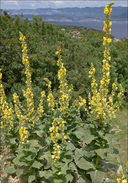|
|
click photo for larger file

Verbascum phlomoides
Orange Mullein
|
Photographer: Dr. Amadej Trnkoczy
ID: 0000 0000 0125 0058 (2025-01-04)Copyright © 2025 Dr. Amadej Trnkoczy
|
|
INFORMATION PROVIDED WITH THE PHOTO
|
date of photo Jun 22, 2020
latitude 45.07015 longitude 14.66909
View on Google Maps.
location
Kvarner Bay, island Krk, south outskirts of the town Vrbnik, next to ham factory 'Gospoja.' (Rijeka region, Croatia)family
Scrophulariaceae
notes Slo.: navadni lučnik - syn.: Verbascum adamovicii Velen., Verbascum australe Schrad., Verbascum belasitzae Stoj. & Stef., Verbascum condensatum Schrad., Verbascum formanekii Formánek, Verbascum pangaeum Murb. & Rech., Verbascum rugulosum Willd.. - Habitat: ruderal stony ground, on bulk material; locally flat terrain; open, sunny, dry place, elevation 95 m (310 feet); average precipitations ~ 1.000 mm/year, average temperature 12-14 deg C, Sub-Mediterranean phytogeographical region. - Substratum: stony ground. - Comment on Flick's album 'Verbascum phlomoides': Verbascum phlomoides is a striking, tall plant with rich yellow flowers that are hard to miss. However, other species with similar habitus and yellow lowers exist, so examining the flower's morphology is essential for accurate identification. - In its first year, Verbascum phlomoides grows a large, dense leaf rosette, and in its second year, it develops its flowering stem and, stretches upwards and can grow up to 2 meters tall. It is native to temperate Europe and Turkey but has since been spread worldwide by humans (Ref.: 4). The leaves are softly hairy on their undersides. Like several species in this genus, the flowers feature two lower stamens longer than the upper three. The hairs on the shorter stamens are whitish, unlike some other species with violet hairs, such as the common Verbascum nigrum. The anthers of the shorter and longer stamens have different shapes. On the longer stamens, the anthers are adpressed to the filament and descend it, while the filament itself is glabrous. In contrast, the shorter stamens have anthers resembling small, centrally attached sausages, and their filaments are distinctly hairy. The pistil has a characteristic green, club-shaped stigma (not spade-shaped). The leaves of the plant do not extend decurrently along the stem like in similar Verbascum densiflorum. Interestingly, once the flower is fertilized, it sheds its fused petals (corolla) so quickly that the phenomenon can be observed with the naked eye. In the old days, the plant was believed to be a highly potent medicine. - Ref.: (1) A. Martinči et all., Mala Flora Slovenije (Flora of Slovenia - Key) (in Slovenian), Tehnična Založba Slovenije (2007), p 548. (2) T. Nikolić, Flora Croatica, Vaskularna flora Republike Hrvatske, Vol. 3., Alfa d.d.. Zagreb (2020) p, 623. (3) W.K. Rottensteiner, Exkursionsflora für Istrien, Verlag des Naturwissenschaftlichen Vereins Kärten (2014), p 873. (4) Euro+Med (2006+), Euro+Med PlantBase - the information resource for Euro-Mediterranean plant diversity. http://www.europlusmed.org [accessed Jan. 2. 2025]camera Sony ILCE6000 / Carl Zeiss Vario-Tessar E 16-70 mm/f4
contributor's ID # Bot_1314/2020_DSC4372 photo category: Plant - annual/perennial
|
MORE INFORMATION ABOUT THIS PLANT
|
| common names
Orange Mullein (photographer)
View all photos in CalPhotos of Verbascum phlomoides Check Google Images for Verbascum phlomoides |
|
The photographer's identification Verbascum phlomoides has not been reviewed. Sign in to review or comment on this photo |
|
Using this photo The thumbnail photo (128x192 pixels) on this page may be freely used for personal or academic purposes without prior permission under the Fair Use provisions of US copyright law as long as the photo is clearly credited with © 2025 Dr. Amadej Trnkoczy.
For other uses, or if you have questions, contact Dr. Amadej Trnkoczy amadej.trnkoczy[AT]siol.net. (Replace the [AT] with the @ symbol before sending an email.) |
|
|
